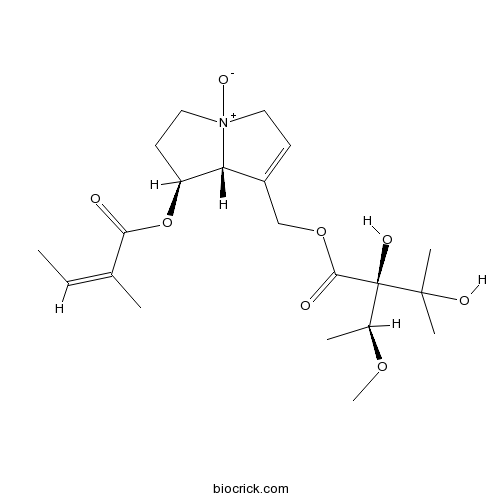Lasiocarpine N-oxideCAS# 127-30-0 |

Quality Control & MSDS
3D structure
Package In Stock
Number of papers citing our products

| Cas No. | 127-30-0 | SDF | Download SDF |
| PubChem ID | 5458800 | Appearance | White powder |
| Formula | C21H33NO8 | M.Wt | 427.49 |
| Type of Compound | Alkaloids | Storage | Desiccate at -20°C |
| Solubility | Soluble in methanol and water; sparingly soluble in ethyl acetate | ||
| Chemical Name | [(7S,8R)-7-[(Z)-2-methylbut-2-enoyl]oxy-4-oxido-5,6,7,8-tetrahydro-3H-pyrrolizin-4-ium-1-yl]methyl (2R)-2,3-dihydroxy-2-[(1S)-1-methoxyethyl]-3-methylbutanoate | ||
| SMILES | CC=C(C)C(=O)OC1CC[N+]2(C1C(=CC2)COC(=O)C(C(C)OC)(C(C)(C)O)O)[O-] | ||
| Standard InChIKey | AABILZKQMVKFHP-LRBDFNDQSA-N | ||
| Standard InChI | InChI=1S/C21H33NO8/c1-7-13(2)18(23)30-16-9-11-22(27)10-8-15(17(16)22)12-29-19(24)21(26,14(3)28-6)20(4,5)25/h7-8,14,16-17,25-26H,9-12H2,1-6H3/b13-7-/t14-,16-,17+,21-,22?/m0/s1 | ||
| General tips | For obtaining a higher solubility , please warm the tube at 37 ℃ and shake it in the ultrasonic bath for a while.Stock solution can be stored below -20℃ for several months. We recommend that you prepare and use the solution on the same day. However, if the test schedule requires, the stock solutions can be prepared in advance, and the stock solution must be sealed and stored below -20℃. In general, the stock solution can be kept for several months. Before use, we recommend that you leave the vial at room temperature for at least an hour before opening it. |
||
| About Packaging | 1. The packaging of the product may be reversed during transportation, cause the high purity compounds to adhere to the neck or cap of the vial.Take the vail out of its packaging and shake gently until the compounds fall to the bottom of the vial. 2. For liquid products, please centrifuge at 500xg to gather the liquid to the bottom of the vial. 3. Try to avoid loss or contamination during the experiment. |
||
| Shipping Condition | Packaging according to customer requirements(5mg, 10mg, 20mg and more). Ship via FedEx, DHL, UPS, EMS or other couriers with RT, or blue ice upon request. | ||
| Description | 1. Lasiocarpine-N-oxide shows antimicrobial activity against selected pathogenic bacteria and fungi. |
| Targets | Antifection |

Lasiocarpine N-oxide Dilution Calculator

Lasiocarpine N-oxide Molarity Calculator
| 1 mg | 5 mg | 10 mg | 20 mg | 25 mg | |
| 1 mM | 2.3392 mL | 11.6962 mL | 23.3924 mL | 46.7847 mL | 58.4809 mL |
| 5 mM | 0.4678 mL | 2.3392 mL | 4.6785 mL | 9.3569 mL | 11.6962 mL |
| 10 mM | 0.2339 mL | 1.1696 mL | 2.3392 mL | 4.6785 mL | 5.8481 mL |
| 50 mM | 0.0468 mL | 0.2339 mL | 0.4678 mL | 0.9357 mL | 1.1696 mL |
| 100 mM | 0.0234 mL | 0.117 mL | 0.2339 mL | 0.4678 mL | 0.5848 mL |
| * Note: If you are in the process of experiment, it's necessary to make the dilution ratios of the samples. The dilution data above is only for reference. Normally, it's can get a better solubility within lower of Concentrations. | |||||

Calcutta University

University of Minnesota

University of Maryland School of Medicine

University of Illinois at Chicago

The Ohio State University

University of Zurich

Harvard University

Colorado State University

Auburn University

Yale University

Worcester Polytechnic Institute

Washington State University

Stanford University

University of Leipzig

Universidade da Beira Interior

The Institute of Cancer Research

Heidelberg University

University of Amsterdam

University of Auckland

TsingHua University

The University of Michigan

Miami University

DRURY University

Jilin University

Fudan University

Wuhan University

Sun Yat-sen University

Universite de Paris

Deemed University

Auckland University

The University of Tokyo

Korea University
- Pimaric acid
Catalog No.:BCN6149
CAS No.:127-27-5
- Taraxerol
Catalog No.:BCN6148
CAS No.:127-22-0
- Sodium acetate
Catalog No.:BCC7587
CAS No.:127-09-3
- Hydroxyurea
Catalog No.:BCC4912
CAS No.:127-07-1
- Locustatachykinin I
Catalog No.:BCC5926
CAS No.:126985-97-5
- 1-(3,4-Dihydroxyphenyl)-7-(4-hydroxyphenyl)heptane-3,5-diyl diacetate
Catalog No.:BCN6572
CAS No.:1269839-26-0
- 5-Hydroxy-1,7-bis(4-hydroxyphenyl)heptan-3-yl acetate
Catalog No.:BCN6586
CAS No.:1269839-24-8
- CDK inhibitor II
Catalog No.:BCC1464
CAS No.:1269815-17-9
- Tetrahydro tanshinone I
Catalog No.:BCN2602
CAS No.:126979-84-8
- Methylenedihydrotanshinquinone
Catalog No.:BCN3221
CAS No.:126979-81-5
- Sar-[D-Phe8]-des-Arg9-Bradykinin
Catalog No.:BCC5996
CAS No.:126959-88-4
- LGX818
Catalog No.:BCC4184
CAS No.:1269440-17-6
- Lutein
Catalog No.:BCN6151
CAS No.:127-40-2
- Vitamin A Acetate
Catalog No.:BCC4748
CAS No.:127-47-9
- 2,2-Bis(4-hydroxy-3-isopropylphenyl)propane
Catalog No.:BCC8494
CAS No.:127-54-8
- Sulfacetamide Sodium
Catalog No.:BCC4383
CAS No.:127-56-0
- Sulfamerazine sodium salt
Catalog No.:BCC5205
CAS No.:127-58-2
- Sulfisoxazole
Catalog No.:BCC4860
CAS No.:127-69-5
- Sulfamerazine
Catalog No.:BCC4854
CAS No.:127-79-7
- Beta-Pinene
Catalog No.:BCC8302
CAS No.:127-91-3
- 4,9-Dimethoxycanthin-6-one
Catalog No.:BCN3107
CAS No.:1270001-72-3
- CGP 42112
Catalog No.:BCC5921
CAS No.:127060-75-7
- Sulfo-NHS-LC-Biotin
Catalog No.:BCC3578
CAS No.:127062-22-0
- Glyceryl hexacosanoate
Catalog No.:BCC8991
CAS No.:127098-14-0
Pyrrolizidine alkaloid-derived DNA adducts are common toxicological biomarkers of pyrrolizidine alkaloid N-oxides.[Pubmed:28987376]
J Food Drug Anal. 2017 Oct;25(4):984-991.
There are 660 pyrrolizidine alkaloids (PAs) and PA N-oxides present in the plants, with approximately half being possible carcinogens. We previously reported that a set of four PA-derived DNA adducts is formed in the liver of rats administered a series of hepatocarcinogenic PAs and a PA N-oxide. Based on our findings, we hypothesized that this set of DNA adducts is a common biological biomarker of PA-induced liver tumor formation. In this study, we determined that rat liver microsomal metabolism of five hepatocarcinogenic PAs (lasiocarpine, retrorsine, riddelliine, monocrotaline, and heliotrine) and their corresponding PA N-oxides produced the same set of DNA adducts. Among these compounds, Lasiocarpine N-oxide, retrorsine N-oxide, monocrotaline N-oxide, and heliotrine N-oxide are for first time shown to be able to produce these DNA adducts. These results further support the role of these DNA adducts as potential common biomarkers of PA-induced liver tumor initiation.


